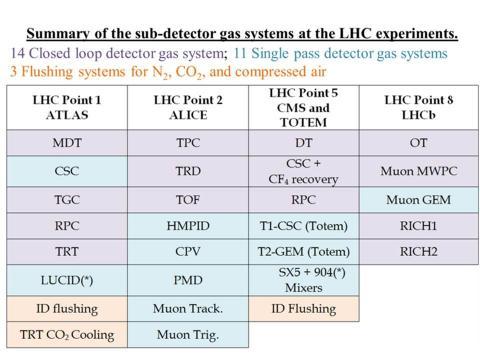Gas Systems for the LHC experiments
Over the five experiments (ALICE, ATLAS, CMS, LHCb and TOTEM) taking data at the CERN Large Hadron Collider (LHC) more than 28 gas systems (corresponding to about 300 gas racks) are delivering the proper gas mixture to the corresponding detectors. The gas mixture is the sensitive medium where the charge multiplication is producing the signal. A correct and stable mixture composition is a basic requirement for good and stable long term operation of all detectors.
The construction started at the beginning of the years 2000. The first systems were put in operation between 2005 and 2006.

The gas systems for the LHC experiments are the result of a common effort between the CERN Gas Service Team (nowadays part of CERN/EP-DT-DI) and the CERN/EN department. The CERN Gas Service Team was responsible for designing, building and operating the gas systems, while CERN/EN for the development of the software controls (following the requirements provided by the CERN Gas Service Team) and the primary gas supply procurement.
The operational experience over the last three years (2010-2012) has demonstrated an impressive reliability level: greater than 99.95% corresponding to less than 1.5 hours of down-time per year (power-cuts and external problem excluded).
The gas systems extend from the surface building where the primary gas supply point is located to the service balcony on the experiment following a route few hundred meters long.
The primary gas supply point is located in the surface building (SG). However, a typical gas system is distributed over three levels (Fig. 1 shows the typical layout of a closed-loop gas system): the surface room (SG), the underground service room (UGC) and the experimental cavern (UXC). The final gas distribution system to the detectors is located in UXC, where also the experiment is installed.
Given the large detector volume and the use of relatively expensive gas components, for technical and economical reason most of the systems are operated in closed loop gas circulation with a recirculation fraction higher than 90-95 %.
